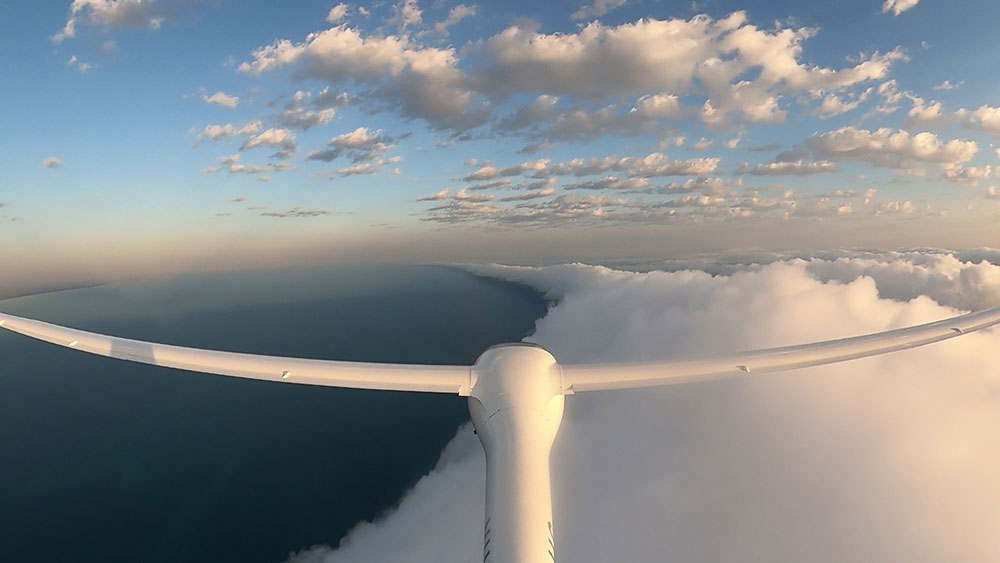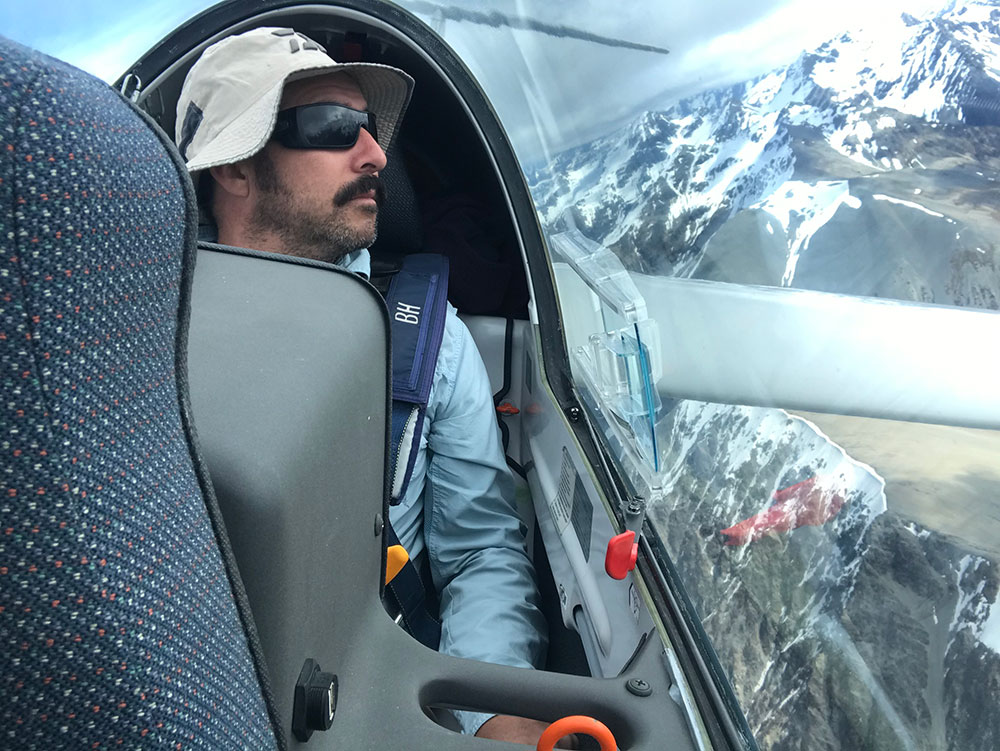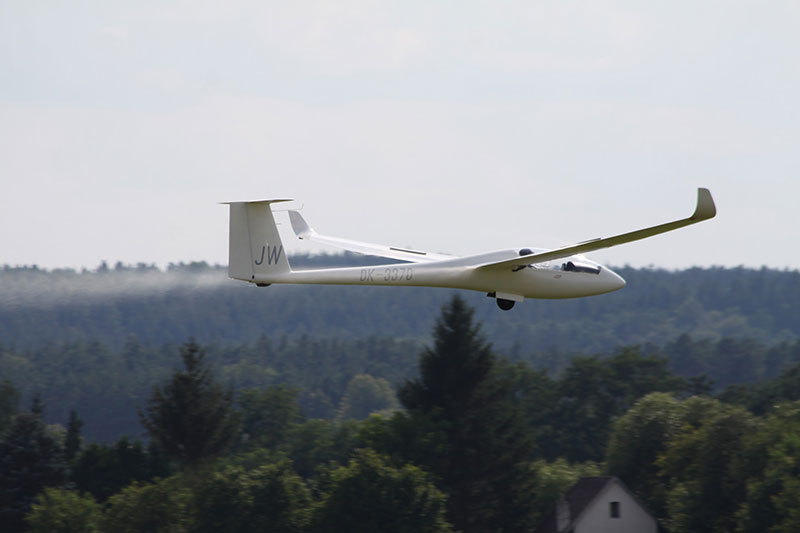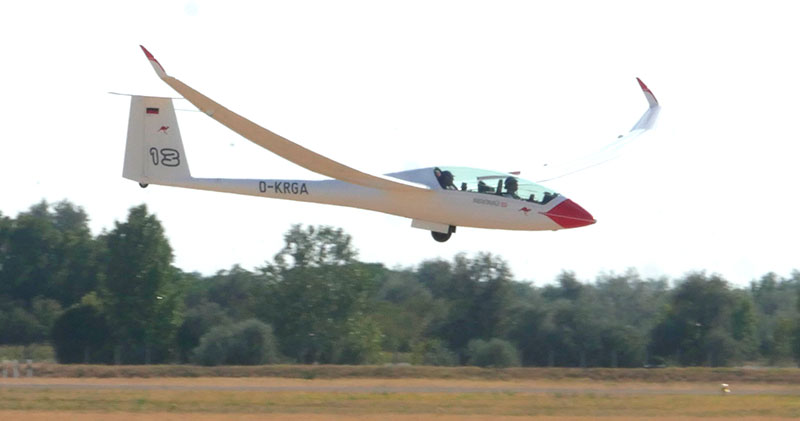Aerophilately is the branch of philately that specialises in the study of airmail. Since the beginning of aviation, enthusiasts have created, collected and studied paper ephemera relating to all aspects of the transport of mail by flight.
by John Patterson
This ephemera can take many forms including official government issued flight related postage stamps, unofficial privately produced non-postal stamps (often referred to as vignettes or cinderellas), envelopes or specially created cards carried on important flights or in aviation competitions and often signed by the pilot, aerogrammes and even baggage labels.
Within aerophilately there are numerous popular specialist areas of interest such as pigeon mail, rocket mail, balloon mail, parachute mail and air crash mail. The latter one – as the name implies – is mail that has been retrieved from a crashed aircraft.
Not unexpectedly, there is also a sub branch of aerophilately known as glider mail. To qualify as glider mail, the item in question needs to have been transported in a glider at some point in its journey to its ultimate recipient, and should include some physical indicator to confirm that.
In addition to the ephemera listed above such as official and unofficial stamps, pilots' signatures and specially created envelopes and cards, other characteristics commonly found on glider mail include custom made rubber stamps known as a cachet promoting the flight or an associated event, printed glider related imagery, a written indication of the type of glider used and/or the name of the pilot, and occasionally even a standard ‘Par Avion’ type of air mail label.
Some glider mail will be transported through normal mail channels after having been carried on a flight and will thus also include the non aviation related postal stamps and cancels. Occasionally, a piece of glider mail will have all of these characteristics.
A glider mail cover can be like a little package of clues that, if properly interpreted, can provide quite specific insight into the origin and purpose of the artefact. To a gliding enthusiast, they can provide a direct link to important moments in gliding history and trigger whole new avenues of glider research.
To demonstrate these various forms of iconography, here are some interesting examples of glider mail originating from outside Australia that are available on a popular auction site at the time of writing:
Images 1 & 2
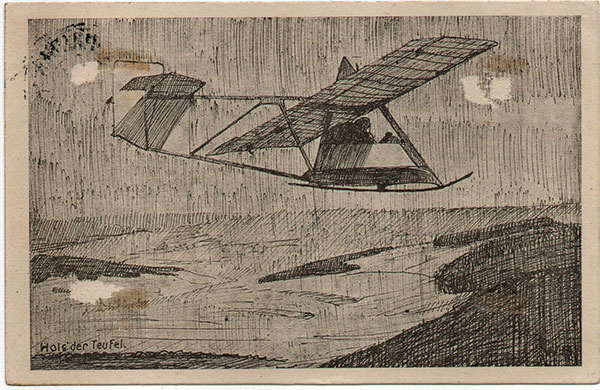

An extremely early example of German glider mail dating from November 1924, this card was carried by glider from the town of Buchelburg to the town of Lehningen, a distance of about 50km as the crow flies. This trip is indicated by a hand-applied rubber stamp. The card was then transported a few kilometres to the town of Neuhausen where it entered the postal system and was delivered to its ultimate destination, most likely the town of Gorlitz, some hundreds of kilometres further away near the Polish border.
The card obviously had some money raising purpose for the publisher, the Aviation Club of Pforzheim, because the text indicates that any profits will be used to further aviation activities.
The card is also a promotion for the featured aeroplane, a Roter Teufel (Red Devil) brand machine of the model type Hols der Teufel, which translates as ‘Devil Take It’ or just ‘Go To Hell’. Wikipedia has this to say on the Hols der Teufel:
The first glider to be named the Hols der Teufel was the influential Djävaler Anamma, designed by Alexander Lippisch in 1923. Its key structural feature was an A-frame which carried wire braced wings and linked to a flat girder rear fuselage. It later evolved through the Schneider Grunau 9 into the very popular Zögling, which avoided the controversial "skullsplitter" forward member of the A-frame with a vertical strut behind the pilot.
This plane was the first series production undertaken by famed sailplane designer and manufacturer Alexander Schleicher after he started his own business. Interestingly, he also has a connection with the next item.
Images 3 &4
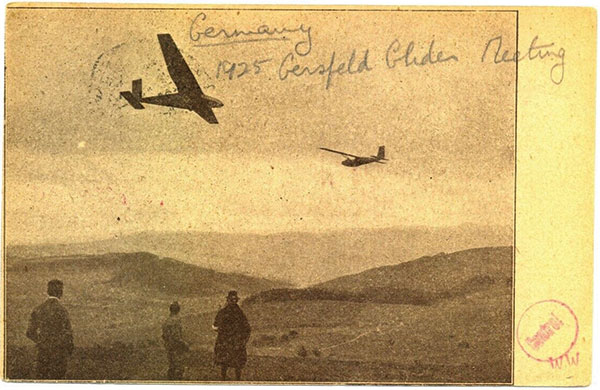
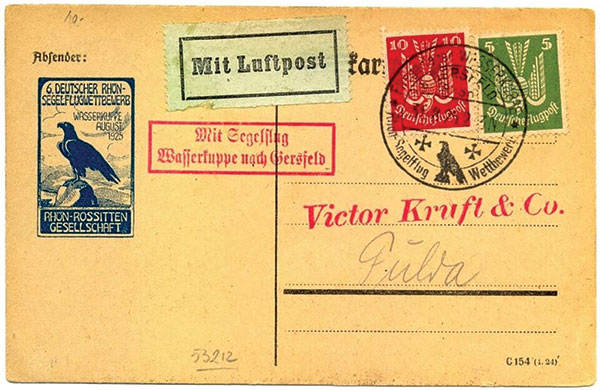
Another very early glider mail item, this illustrated letter card was prepared for the 6th German gliding competition in August 1925 and was flown about 5km on 31 August from the well known gliding centre of Wasserkuppe to the nearby town of Gersfeld. Information available on the web indicates that “the mail was transported by the well known Rhone veteran Gottlobb Espenlaub who dropped the mailbag in front of the post office at Gersfeld”. From Gersfeld it was transported through the German mail system to its final destination in the nearby town of Fulda.
The front of the card features a fascinating photo of people watching early gliders in action, with a hand written attribution to a gliding meet at Gersfeld. The reverse features a printed cachet with an eagle on the left that promotes the competition as well as the name of the event sponsor, the Rhon Rossitten company. This company provides the link to Alexander Schleicher mentioned above – he worked on sailplane construction for the Rhon Rossitten company at Wasserkuppe before going out on his own and building the Hols der Teufel.
On the right side of the reverse is a postal cancel mark created by the German Reichspost as a one-off for this flight. Apparently this cancel was designed by a member of the Vereinigung ehemaliger Feldfliegertruppen (Association of Former Field Pilots), which would account for the fairly militaristic nature of the cross and eagle imagery. This connection points to the important role that ex-members of the German air force played in the development of aviation, and particularly gliding, in their country in the years following World War 1.
The reverse also features a very early German Mit Luftpost (By Airmail) sticker and a small red hand stamp identifying the item as having been flown by glider between Wasserkuppe and Gersfeld.
The pilot Gottlob Espenlaub was himself a noted early sailplane designer who is co-credited, along with Gerhard Fieseler, as the first person to demonstrate the effectiveness of the aerotow – their demonstrations lead to the eventual broad adoption of the launch technique. Espenlaub went on to spend much of the rest of his career designing rocket-propelled gliders – which sounds like a tautology to me.
Images 5 & 6
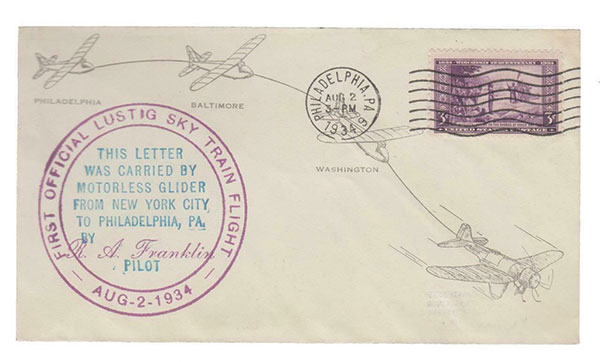
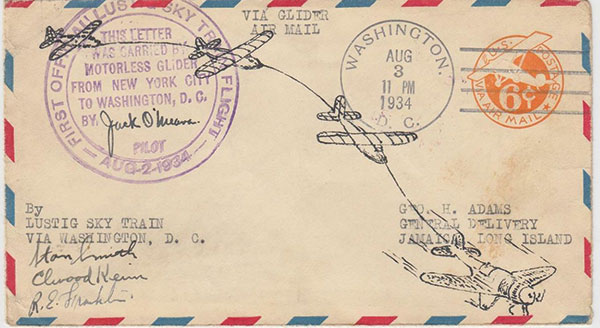
These two covers dating from 3 August 1934 are artefacts carried on the ‘Lustig Sky Train’ – a remarkable experiment to test the potential effectiveness of the glider as a regular mail and goods delivery service. A powered plane took off from New York towing three Franklin PS-2 Gliders. This sky train flew to Philadelphia, Baltimore and Washington DC, releasing one glider over each city carrying mail intended for that city. Figure 5 shows a cover flown to Philadelphia, while Figure 6, a cover flown all the way to Washington, has been signed by all four pilots on the sky train and thus is considerably scarcer.
Images 7 & 8

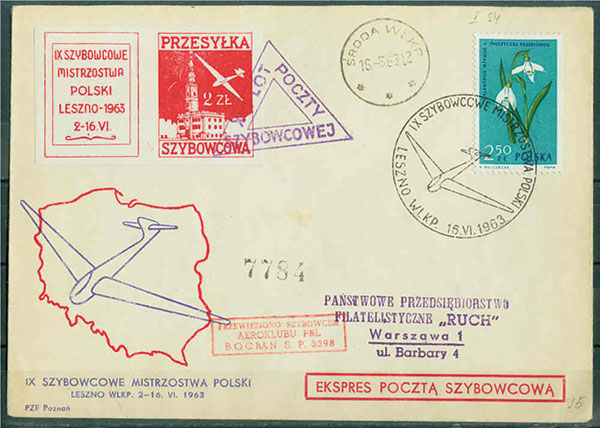
These two fabulous Polish covers dating from 1958 and 1963 each feature a dazzling array of iconography, including printed envelopes, special vignette stamps, numerous stamps referencing Glider Mail, the model and call number of the aircraft used, a specially designed cachet, Express Post designations and postal cancels indicating subsequent transmission through the postal system. As if that wasn’t enough, Fig 7 also carries two official Polish postage stamps with a design featuring a glider. Figure 7 was created in conjunction with a philatelic exhibition held in the town of Leszno, and Figure 8 is associated with the 9th Polish Gliding Championships, also held in Leszno. I liked Figure 7 so much when I saw it that I bought it!
Image 9
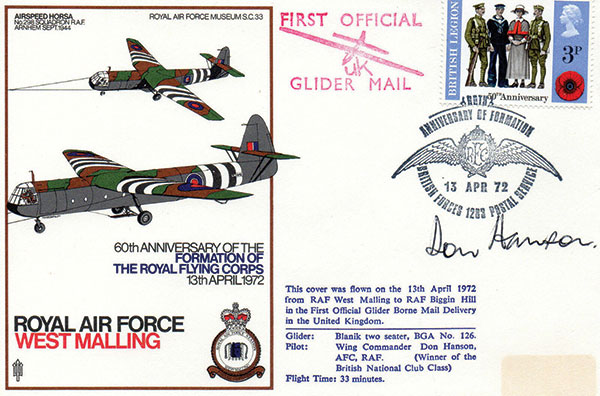
This rare example of an official Government sponsored glider mail release is a 1972 cover produced for carriage by glider as part of the 60th anniversary celebrations of the British Royal Flying Corp. As well as the red ink cachet, the flight details and the pilot’s signature, the cover features a British Forces Postal Service cancel designed specifically for postal material associated with the 60th anniversary celebrations. The cover also shows a large printed image of two RAF Airspeed Horsa gliders from No 298 Squadron under tow in 1944.
Image 10
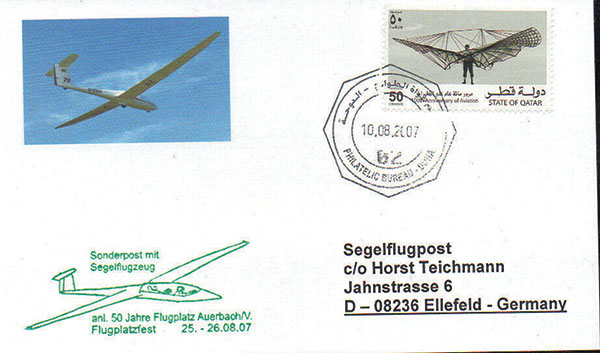
This 2007 cover was produced in commemoration of the 50th anniversary of the Auerbach airfield in Germany. The cover was transported by normal post from Qatar using a Qatar 100th Anniversary of Aviation postage stamp which features an image of a very early pioneering glider design.. The cover also features a printed photo of a modern glider. Upon arrival at Ellefield in Germany the cover was transported to the Auerbach airfield where it was carried by glider before receiving the green cachet stamp.
Australian Glider Mail
Aerophilately is a popular pastime in Australia so it is no surprise that a number of glider mail articles have been produced here.
Image 11
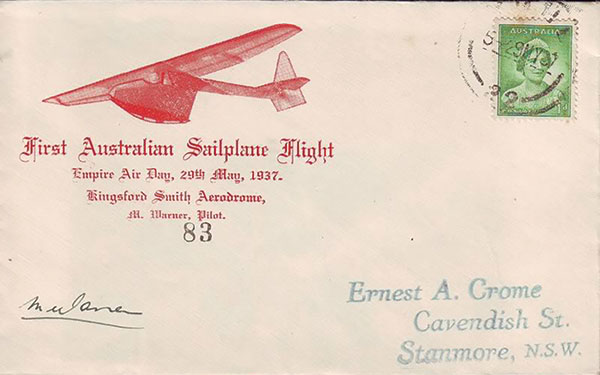
This marvellous and very scarce cover was created to commemorate the first Sailplane Flight in Australia that took place during the Empire Air Day at Kingsford Smith Airport on 29 May 1937. 125 covers were flown by Pilot M Warner. The covers were individually numbered and each was signed by the Pilot.
Image 12
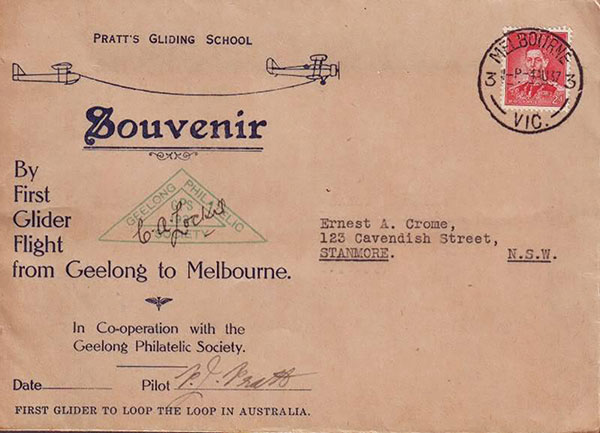
Also created in 1937, this cover was one of 600 carried by pilot PJ Pratt on the inaugural glider flight from Geelong to Melbourne. The image on the cover would suggest that the glider was under tow most of the way. The cover proudly proclaims that the glider used was the first to loop the loop in Australia. The cover was created in co-operation with the Geelong Philatelic Society and is signed by both a representative of the society and the pilot.
The recipient of both this envelope and that displayed in Figure 11, Ernest Crome, is regarded as one of the three towering figures in Australia aerophilately. The other two are Nelson Eustis and Tom Frommer.
Image 13
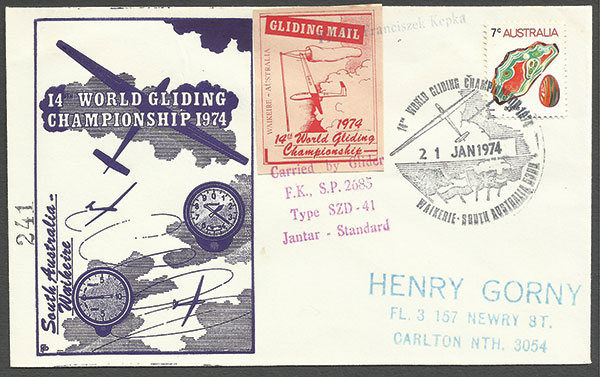
A number of glider mail articles was created for the 14th Gliding World Championships held in Waikerie, South Australia during January 1974. On 21 January 1974, the Polish team organised the transport of 442 covers by Polish Team member Franciszec Kepka on a 455km competition flight that followed the course Waikerie – Spalding – Robertstown – Laxton – Waikerie. Kepka placed third that day. On arrival at Waikerie, the covers were officially cancelled at a special mobile post office that had been set up at the airfield, thus allowing them to enter the postal system for transmission to their ultimate destinations.
These individually numbered covers feature a specially produced envelope design, the flight details, a hand stamp of the pilot’s name in lieu of an autograph, a specially designed Australia Post cancel and one of four different coloured privately produced vignette stamps created for attachment to the glider mail.
Image 14
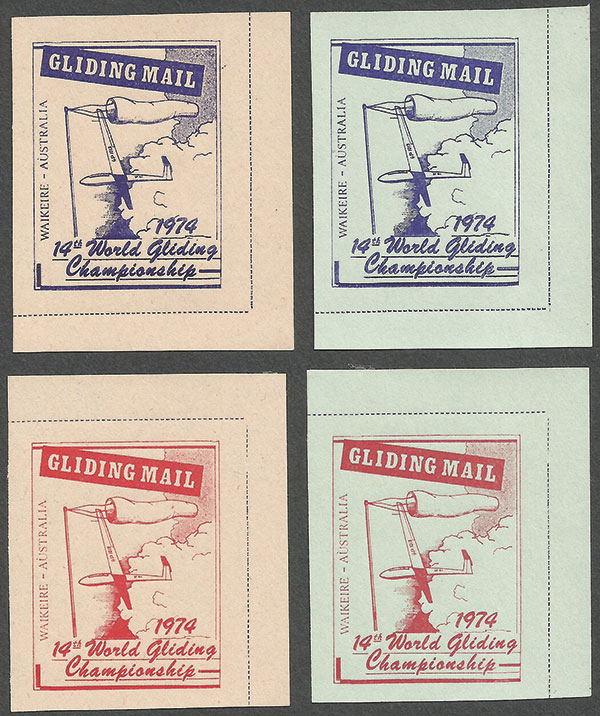
These are the four different coloured vignette stamps produced by the Polish team for attachment to their glider mail carried at the 1974 World Championships. Sadly, glider mail vignettes are rarely produced in Australia.
Image 15
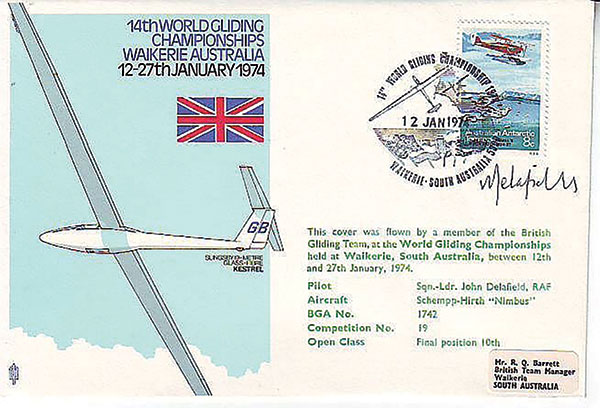
In addition to the items shown in Fig 13 and Fig 14, the 1974 Gliding World Championships at Waikerie also saw the creation of another series of covers carried during the competition. 36 pilots from 18 different countries each carried around seven covers. Each of these featured a specially printed envelope that also carries the flight details, the pilot’s signature and the same official postal cancel issued by a special mobile post office that had been set up at the airfield. In common with Figure 13, once cancelled, these covers were then transmitted through normal Australia Post channels.
I hope you have enjoyed this brief introduction to glider mail. It is an area that allows enthusiasts to own tangible relics of notable events in world gliding relatively inexpensively and can also trigger some quite fascinating avenues of research, especially with the magic of the internet at one’s fingertips.
If you would like to find out more about the subject, you could look out for the book ‘Glider Mail - an Aerophilatelic Handbook’ written by Simine Short and Dan Barber (Published 1987 Amer Airmail Society). I should add that although I haven’t seen this book, I suspect it would be worthwhile pursuing. For information on every aspect of Australia’s aerophilately, including glider mail, your best resource is the 8th edition of The Australian Air Mail Catalogue, a relatively recent edition by Nelson Eustis and Tom Frommer. This book is a magnificent production which would be of interest to most aviators, not just those interested in aerophilately.
I would be interested in seeing any other examples of Australian Glider mail that you may own. Please email if you have any examples you would like to share.
About the Author: John Patterson is a Sydney based records officer and amateur antiquarian. He has been interested in gliding ever since 1975 when Rob Hall became his stepfather.




























